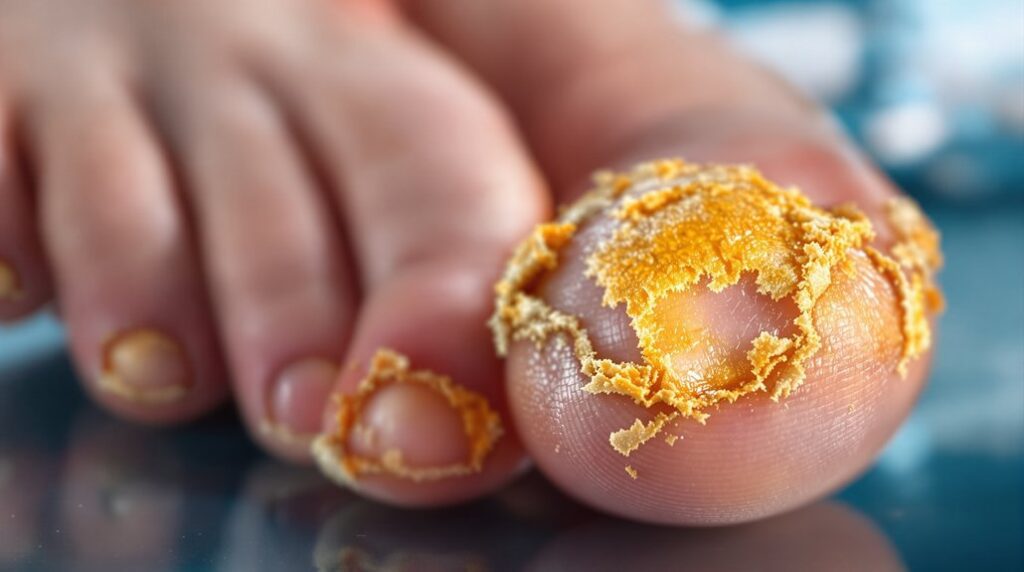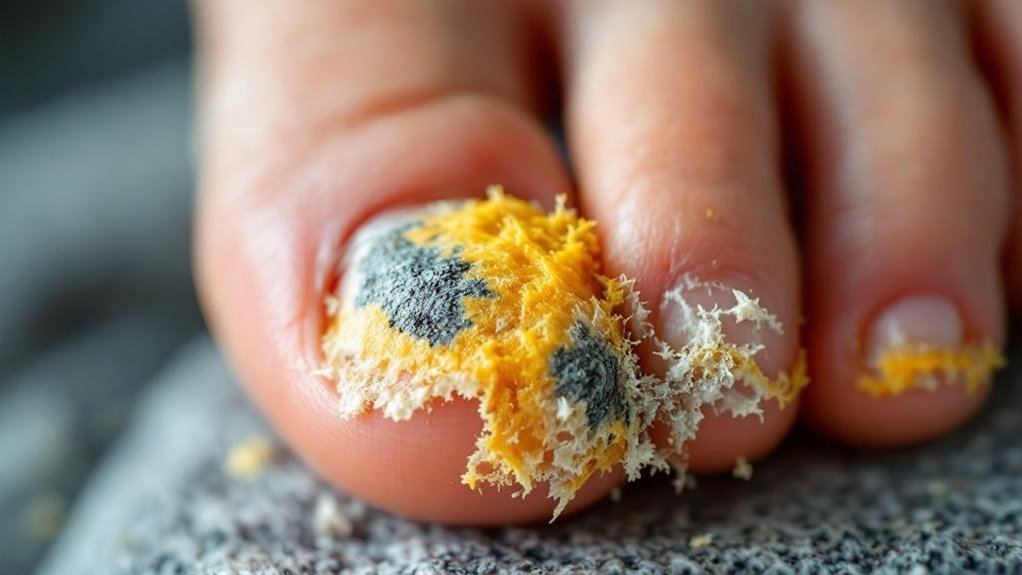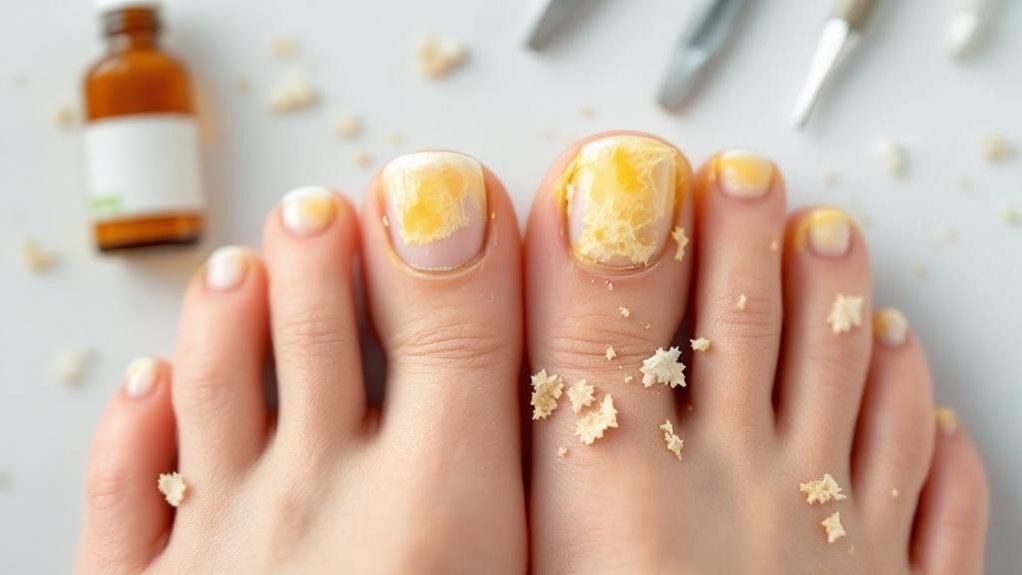Posted by: Skin And Cancer Institute in Medical Dermatology

Nail fungus (onychomycosis) affects up to 10% of people globally, with higher rates in older adults. It’s caused by dermatophytes, yeasts, and molds that thrive in warm, moist environments. We’ll cover the progression from mild discoloration to thickened, brittle nails, along with medical treatments, home remedies, and prevention strategies. Whether you’re dealing with early symptoms or persistent infection, understanding treatment options and preventive measures will help maintain long-term nail health.
Key Takeaways
- Nail fungus infections begin with mild discoloration and progress to thicker, brittle nails with yellow-brown appearance.
- Common risk factors include age, poor circulation, diabetes, excessive sweating, and damaged nails.
- Treatment options range from over-the-counter products to prescription oral antifungals and medicated nail polishes.
- Natural remedies like tea tree oil can be effective for early infections when used consistently.
- Prevention requires keeping nails dry, wearing protective footwear in public areas, and avoiding sharing personal nail tools.
Understanding Nail Fungus: Causes and Risk Factors

Although nail fungus affects millions of people worldwide, it remains widely misunderstood. We find that most infections are caused by dermatophytes, a common group of fungus types that thrive in warm, moist environments. However, yeasts and molds can also be culprits in certain cases.
Infection transmission typically occurs through direct contact with contaminated surfaces like pool decks, shower floors, or shared nail tools. We’ve identified several risk factors that increase susceptibility, including age (older adults are more vulnerable), diminished blood circulation, excessive sweating, and compromised immune systems.
You’re also at higher risk if you have diabetes, athlete’s foot, or a history of nail injuries. Understanding proper foot hygiene helps us develop targeted prevention strategies for our patients who want effective protection against this persistent condition.
Recognizing the Symptoms and Progression of Fungal Nail Infections
Nail fungus often presents with subtle initial symptoms that worsen gradually without treatment. As dermatology specialists, we’ve observed that early symptom identification typically includes mild discoloration—usually white or yellow spots on the nail surface.
As infection progression continues, patients notice their nails becoming thicker, more brittle, and increasingly discolored, often turning yellow-brown. The nail may separate from the nail bed (onycholysis) and develop a distorted shape. In advanced cases, the nail can become crumbly, with debris accumulating beneath it, sometimes accompanied by a slight odor.
We understand how concerning these changes can be. Many of our patients report feeling self-conscious about their nails’ appearance. Recognizing these progressive symptoms early allows for more effective treatment before the infection becomes deeply entrenched in the nail structure.
Medical Treatment Options: Prescription Medications and Procedures

When nail fungus persists beyond home treatments, prescription medications and medical procedures become necessary therapeutic options. At our practice, we offer extensive solutions tailored to the severity of your infection.
Oral antifungals, including terbinafine and itraconazole, effectively treat fungal infections from within by promoting new, healthy nail growth over several months. These medications require liver function monitoring but yield high success rates for persistent cases.
For patients who can’t take oral medications, prescription-strength topical treatments containing ingredients like ciclopirox or tavaborole provide targeted therapy. These solutions penetrate the nail plate to combat infection directly.
In severe cases, we may recommend nail debridement or removal procedures to eliminate heavily infected tissue before beginning medication. Together, we’ll determine the most appropriate treatment approach for your specific condition.
Home Remedies and Over-the-Counter Solutions
Many patients seeking relief from nail fungus can benefit from accessible home remedies and over-the-counter solutions before pursuing medical intervention. We recommend several evidence-based approaches that may help manage mild to moderate infections. Essential oils like tea tree, oregano, and thyme offer antifungal properties when applied consistently to affected nails. Dilute these oils with a carrier oil to prevent skin irritation.
Natural exfoliants containing urea can help remove infected nail tissue while improving topical medication penetration. Over-the-counter antifungal solutions containing undecylenic acid or tolnaftate may provide relief for early-stage infections.
Daily application of these products, combined with proper nail hygiene, creates an environment less hospitable to fungal growth. We recommend trying these conservative options for 3-6 months before determining if prescription treatment is necessary.
Prevention Strategies for Long-Term Nail Health

Although fungal nail infections can be persistent, implementing proper preventive measures considerably reduces recurrence risk. We recommend maintaining daily nail care routines, including keeping nails short, clean, and dry.
After showering or swimming, thoroughly dry your feet, paying special attention to the spaces between toes where moisture accumulates.
Proper hygiene practices extend to your footwear as well. Rotate shoes daily to allow them to fully dry, use moisture-wicking socks, and consider antifungal powders in shoes that tend to retain moisture.
Avoid sharing personal items like nail clippers, files, or towels that could transmit fungal spores. For our patients who frequent public pools or gym showers, we suggest wearing protective footwear in these communal areas where fungal organisms thrive in warm, moist environments.
Frequently Asked Questions
Can Nail Fungus Spread to Other Parts of the Body?
Yes, nail fungus transmission can occur to other parts of your body. We see patients who develop body fungus elsewhere when they touch infected nails and transfer the infection to different areas.
Is Nail Fungus Contagious Between Family Members?
Yes, nail fungus can be transmitted between family members. We recommend maintaining proper family hygiene practices, including not sharing nail care tools and wearing protective footwear in shared spaces to prevent cross-contamination.
How Long Does Nail Fungus Treatment Typically Take to Work?
Nail fungus treatment duration typically ranges from 3-12 months. We find effective remedies include oral antifungals, topical solutions, and laser treatments. Patience is essential for our patients’ successful outcomes.
Will My Insurance Cover Nail Fungus Treatments?
Many insurance plans cover medical treatments for nail fungus, though coverage varies. We’ll help determine your insurance coverage and discuss all treatment options during your consultation at our dermatology practice.
Can I Get a Pedicure if I Have Nail Fungus?
We don’t recommend pedicures with nail fungus as they can spread infection. Focus on proper foot hygiene instead. If you proceed, inform your nail technician and guarantee thorough tool sterilization for safe nail care.
Conclusion
We’ve outlined the critical aspects of nail fungus management in this guide. While treatment requires patience, combining professional therapies with diligent home care yields ideal results. Early intervention greatly improves outcomes. Remember that prevention remains essential—proper hygiene, moisture control, and regular nail assessment are your best defenses. Don’t hesitate to consult our dermatology team if you’re experiencing persistent symptoms of fungal nail infection.